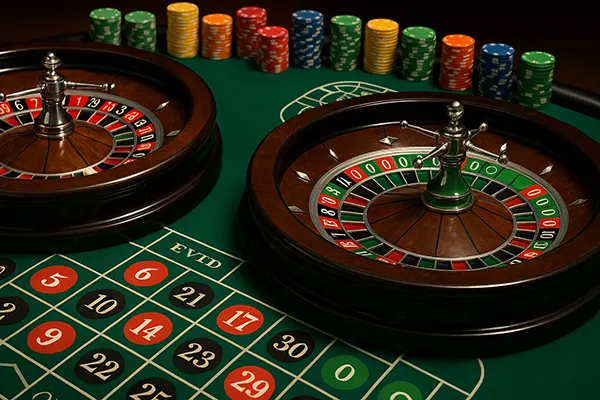
European vs American Roulette: Why One Zero Makes All the Difference
Roulette has long held a place of prestige in both land-based and online gambling venues. Two of its most recognised variants — European and American — may seem nearly identical at first glance. However, the placement of a single extra zero in American roulette leads to major differences in odds, strategy, and player preference. This article provides a detailed breakdown of how one small detail shapes the entire gaming experience.
The Layout: One Extra Zero, Big Consequences
European roulette features 37 pockets, numbered from 1 to 36, plus a single zero. American roulette, on the other hand, includes an additional double zero (00), bringing the total to 38 pockets. While this seems like a minor distinction, it significantly alters the house edge. In European roulette, the house edge stands at approximately 2.7%, whereas in the American version, it jumps to 5.26% due to the extra zero pocket.
This increased house edge impacts the long-term returns for players. Those who play identical strategies across both formats will see more consistent and fair outcomes in European roulette. The more pockets a wheel contains, the lower the probability for any single bet to win, which is why serious players often gravitate toward the European format.
The positioning of the numbers on the wheel also differs between the two versions. While it might not change the outcome of a random spin, it does influence advanced strategies such as sector betting and bias wheel analysis, which depend on consistent wheel structures.
Understanding the Impact on Betting Systems
The influence of the extra zero becomes especially apparent when using betting systems like Martingale or Fibonacci. These systems rely on predictable returns based on even-money bets. In American roulette, the additional double zero means there’s a greater likelihood that a bet will fall outside these even categories, such as red/black or odd/even.
For players using progressive strategies, the expected value decreases in American roulette. Over time, repeated exposure to a 5.26% house edge results in more significant losses. That is why even the most popular systems are less effective on an American wheel.
Moreover, many betting systems assume a symmetrical layout, which is more closely maintained in the European variant. This allows for more refined and balanced approaches when placing split or corner bets, especially among seasoned players.
House Edge and Payouts: What the Numbers Say
In both versions of roulette, standard payout structures apply: 35 to 1 for a single number, 17 to 1 for a split, 11 to 1 for a street, and so forth. However, due to the house edge, the probability of hitting each bet changes depending on the number of pockets. For example, a straight-up bet in European roulette has a 2.7% chance of winning, compared to 2.63% in American roulette.
These slight shifts in probability affect cumulative results across hundreds of spins. High-frequency players, especially in online roulette sessions, feel the effect more profoundly. Even a 0.07% difference can translate into thousands of units over time for committed gamblers.
Additionally, European roulette often includes the “en prison” or “la partage” rules in some versions. These rules return part or all of the stake when the ball lands on zero and the player has placed an even-money bet. This further reduces the house edge to as low as 1.35% — a significant advantage not typically found in American roulette.
Strategic Considerations for Choosing a Wheel
Players aiming for long-term gains often choose European roulette due to its lower house edge and more favourable rules. This doesn’t only apply to professional players — casual players benefit from better returns too, making their sessions last longer and potentially more rewarding.
Meanwhile, American roulette is more common in land-based casinos across North America, where traditions and infrastructure play a role. Despite the higher edge, it remains popular due to regional availability and established habits.
Ultimately, strategy begins with understanding the mathematical foundation of the game. Choosing a version of roulette with better odds is one of the simplest — yet most effective — ways to maximise returns without changing how you play.

Global Preferences and Online Availability
The choice between European and American roulette is not just a matter of preference; it also depends on availability. European roulette dominates in European countries and online casinos based in regions with stricter gaming regulations. These formats are often presented with advanced features, professional live dealers, and enhanced visual interfaces.
In contrast, American roulette maintains its hold in many North American jurisdictions, both in physical casinos and online environments targeting players in the US. However, international players generally have easier access to European variants thanks to regulatory frameworks and demand-driven supply.
Mobile gameplay also influences the distribution of roulette types. Many online operators prioritise European roulette for mobile apps due to its favourable odds and appeal to a broader international audience. This makes it the default format in most modern digital gambling environments.
Which Variant Is Better for You?
Deciding between European and American roulette ultimately depends on your priorities. If lower house edge and better odds are crucial, European roulette is the logical choice. Its structure supports longer play sessions and more stable outcomes for both strategic and recreational players.
However, if you’re playing in a North American land-based casino, your options might be limited to the American version. In this case, awareness of the odds and adapting your strategy becomes more important than the wheel itself.
Knowledge of both roulette types allows players to make informed decisions. Whether you play for leisure or with a strategic mindset, understanding how one zero influences the entire game is essential to success.
